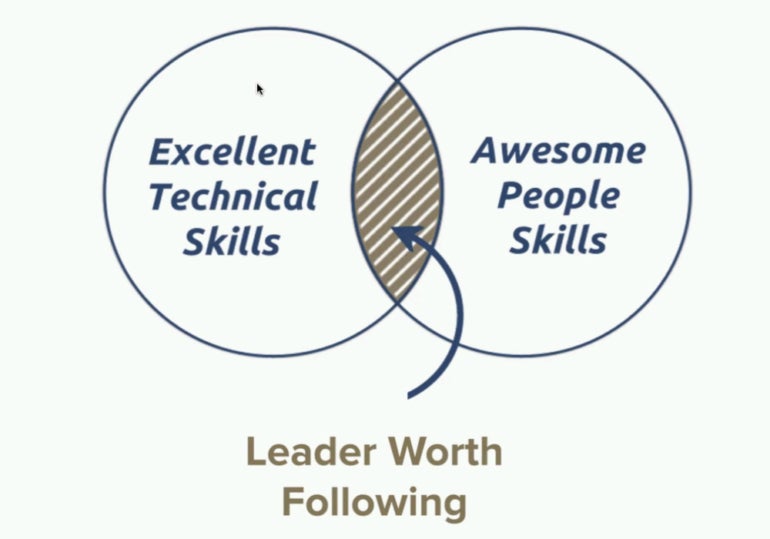Some Australian IT professionals with aspirations of moving into leadership roles are hitting a “technical ceiling” within their organisations, but there are ways they can also develop into strong people leaders, according to an innovative Australia-based leadership psychologist.

Duncan Fish, head coach and founder at Australian executive coaching business The Engaging Executive, said technical professionals at the middle-manager level often either stop being promoted, or end up struggling in senior leadership roles due to underdeveloped people skills.
Fish argues that structured insights from psychology, combined with the intentional practice of these skills in the workplace, can help more Australian IT professionals who have the motivation to learn become trusted, empathetic and influential leaders within their organisations.
IT professionals are struggling with a ‘technical ceiling’ problem
Duncan Fish has worked with a range of mid-level and senior managers in the Australian market. He said the IT executives he sees, like other technically-oriented professionals, are often rewarded in school, university and their early career for technical skills and knowledge.
“They have been continually reinforced down that technical path and rewarded for their technical prowess,” Fish said in an interview with TechRepublic in Australia.
At about the middle-manager level, perhaps after a couple of promotions, Fish said they reach a transition point. While they still need to be experts in their field, they find that just getting deeper and deeper into their technical skill area will not progress them any further.
This transition point can become a “technical ceiling” for potential leaders. While there are “unicorns” that do make the transition and flourish naturally into people leaders, quite often, it is something that needs to be developed in technical professionals if they are to thrive.
Two things happen to IT professionals at the technical ceiling
IT professionals who reach the technical ceiling usually face one of two problems:
- They find their career stalls, and they are not promoted due to a lack of what can often be termed leadership, soft, interpersonal or stakeholder management skills.
- They get over-promoted, which can leave them struggling in more senior roles where they do not understand the new skills they need to develop to continue their success.
The technical ceiling barrier could be getting stronger. Research released by the CSIRO, which analysed 2 million online job advertisements in Australia between 2015 and 2022, found an increase in demand for employees with interpersonal skills following the COVID-19 pandemic.
The accelerated demand for interpersonal skills was primarily driven by an increase in job postings seeking skills in communication and collaboration, according to lead author and CSIRO scientist David Evans, and these skills were in demand even for remote working positions.
SEE: The three pillars of a successful tech leadership career.
How potential KPMG stars failed at the partnership finish line
Fish first noticed the technical ceiling problem while working with KPMG in the U.K., where he helped select potential partners. The final stage involved a three-day assessment with simulated business, staff and customer meetings, where softer skills of leadership were being assessed (Figure A).

“They had already proven their technology skills and business acumen to get to that stage,” Fish said. “This is where I saw people make it or break it … There was only a small percentage that could actually really muster those softer leadership skills.”
IT pros need to focus on connection, understanding and influence
IT professionals with leadership transition problems essentially need to start developing their people skills.
“They need to be able to connect, understand and influence other people on non-technical matters, because there are lots of non-technical people they have to deal with.”
Psychological science has a lot to offer these aspiring leaders. Fish, whose Australia-based team of 10 includes psychologists from different disciplines, likens his model to “mixed martial arts”. The Engaging Executive draws on organisational, evolutionary, social, clinical and positive psychology as well as neuro linguistic programming to develop and hone holistic people skills in three key areas (Figure B).

Connecting with teams and business stakeholders to build trust
Although Fish warns against generalisation, he said it is common for technical professionals to tend towards introversion. They may be more comfortable dealing with computers than people. Logic, data, facts and processes can become a “safe space”, and they can often appear aloof.
Connection skills help these or similar individuals develop relationships more deeply and broadly across silos and different types of people. This includes building confidence to walk into any room and techniques to manage body language, voice, eye contact and facial expression.
“We also help them to have magnetic conversations, whether that is storytelling, using a bit of humour, or just making a two-way conversation flow effortlessly,” Fish said. “Because this stage is all about building trust — people have to trust or be comfortable with you for you to get anywhere else.”
Understanding people better by moving from ‘apathy’ to ‘empathy’
Technical professionals usually have good cognitive understanding, but often need to learn to understand people better, Fish said. They may see people as “unpredictable”; the emotions or ups and downs of team members can seem like a “computer bug” rather than just being human.
“When you lead other people or you have to deal with stakeholders that have different ways of being, then you need to be able to understand — so this is about developing empathy. “It’s about developing tolerance for other people, developing your emotional intelligence,” he said.
Influencing outcomes by involving people rather than instructing them
Without first being able to connect and understand other stakeholders, executives who try to wield influence to achieve their desired outcomes can “come across as manipulative”.
Technical professionals gain influence by shifting from “instructing” to involving people. This can be achieved through things like asking insightful questions that tap into people’s hopes, needs and fears and compelling linguistics that “go up from the technical into the generic”, Fish said.
Results show technical professionals can learn people skills
Technical professionals can be trained to overcome the technical ceiling. Independent internal measurement conducted by a top tier Australian public sector client working with The Engaging Executive measured significant improvements among employees sent through the program. Participants showed an improvement of between 14% and 83% across 15 target behaviours within six months, according to results verified by both participants and their direct managers.
SEE: Six styles of product leadership and how to use them effectively.
The results included 100% of participants appearing approachable and friendly to work colleagues (up 14%) and a 34% improvement in their ability to effectively manage the behaviour and performance of teams. There was an 83% improvement in influence by ‘asking the right questions and chunking up and down’, referring to moving from the specific to general.
What IT professionals need to do to breach the technical ceiling
Australian IT professionals can move successfully through the technical ceiling into leadership roles. However Fish said that, “like everything in life, if there’s no motivation or there’s no will to learn, then it can be hard. It has to start there; it has to start with the desire.”
Beyond basic motivation, Fish has three recommendations to help develop people skills.
Find an expert guide who can support people skills development
It is unlikely technical IT professionals will “magically” learn the people skills they need to lead on their own. Fish said the most effective path is to connect with an expert guide.
“You need to find someone, whoever that is, that is better than you at the skills you want to learn,” said Fish.
Follow a tried and tested process that breaks learning into stages
Technical professionals often benefit from following a more structured, tried and tested process, primarily because it enables them to break learning new skills down into small steps or stages.
“These professionals can be logical and factual and data driven, so often, people skills can seem like a mystical thing and they don’t know where to start,” Fish said. “It’s absolutely key, whether they read self-help books or go on courses or get a coach, to be able to break it down into stages.”
Commit to a process of deliberate practice in a work environment
IT professionals will embed people skills more effectively if they break them down and practise each element deliberately in practical scenarios. An example would be deciding to practise a particular influencing skill and then working a particular type of question into a conversation.
Fish said Professor K. Anderson Ericsson’s study of prodigies, popularised by Malcolm Gladwell in his book Outliers, showed that becoming skilled at something is not just about putting in 10,000 hours, but about breaking things down into nano-parts and practising each one intently.
“This is the difference between people who are good learners and people who are not; if people take one thing they listen to on a podcast or see on YouTube and put that into practice today or not just today but all week, then they will see a difference. It’s all about the doing,” Fish said.
